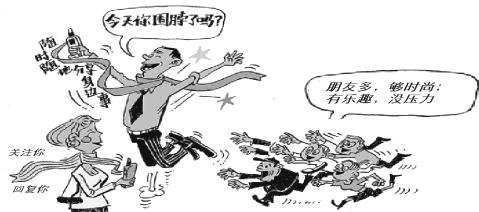ЬтФПФкШн
19ЃЎЕБНёЃЌЮЂВЉвбдНРДдНЖрЕиЮЊШЫУЧЫљНгЪмЃЌЧрЩйФъвВВЛР§ЭтЃЎЫќдкШЫУЧЕФШеГЃЩњЛюжавбОГЩЮЊвЛжжЪБЩаЃЌвЛжжБиВЛПЩЩйЕФЙЄОпЃЎЕЋЙ§ЖШЛђВЛЕБЕФЪЙгУВЛНіРЫЗбЪБМфЁЂОЋСІКЭН№ЧЎЃЌЛЙЛсгАЯьЩњЛюЕФКЭаГЃЎЧыИљОнЯТЭМЬсЪОЃЌгУгЂгяаДвЛЦЊЖЬЮФЃЌУшЪіЭМЦЌЫљЪОЯжЯѓМгвдЗжЮіЃЌВЂЬИЬИИіШЫЖдДЫЕФЙлЕуЃЈжСЩйСНЕуЃЉЃЎ
зЂвтЃК1ЃЎДЪЪ§150зѓгв ЃЈПЊЭЗвбИјГіВЛМЦШызмДЪЪ§ЃЉ
2ЃЎПЮВЮееЭМЪОМАЩЯУцЕФЫЕУїзїБивЊЕФЯыЯѓКЭЗЂЛгЃЌЕЋВЛвЊж№ОфзїМђЕЅЗвыЃЎ
3ЃЎВЮПМДЪЛуЃКЮЂВЉ microblog nЃЎЃЛ ЪБЩаvogue nЃЎ
MicroblogЃЌas its name indicatesЃЌis a kind of blogЃЌwhich differs from a traditional blog in that its content is smaller in sizeЃЎ _____________ЃЎ
ЗжЮі БОЮФЪЧвЛЦЊПЊЗХадзїЮФЃЌвЊЧѓИљОнЭМЦЌФкШнЖдЮЂВЉетвЛЯжЯѓНјааЗжЮіЃЌВЂаДГіИіШЫПДЗЈЃЎ
аДзїЪБШЫГЦвдЕквЛШЫГЦЮЊжїЃЌЪБЬЌвдвЛАуЯждкЪБЮЊжїЃЎ
жиЕуЖЬгяЃКrelieve the pressure from ЃЈЛКНтЁбЙСІЃЉЃЌkeep well-informed of ЃЈЖдЁЯћЯЂСщЭЈЃЉЃЌa symbol of ЃЈЁЕФБъжОЃЉЃЌbe concerned about ЃЈЙиаФЃЉЃЌbe occupied in/addicted to ЃЈЖдЁзХУдЃЉ
ИпЗжОфаЭЃК
1ЃЎThere is no denying that it has become a symbol of vogue and brought much convenience to our lifeЃЎ
There is no denying thatЁ"ЁЪЧВЛПЩЗёШЯЕФ"ЃЌthatв§ЕМЕФЭЌЮЛгяДгОфЃЎ
2ЃЎNot only can we respond to it immediately but also we can type some words in reply to them if we are interestedЃЎ
not onlyЁbut alsoЁЃЌв§ЕМСНИіОфзгЪБЃЌnot onlyКѓЕФОфзгвЊЪЙгУВПЗжЕЙзАЃЎ
3ЃЎAs the saying goesЃЌ"The water that bears the boat is the same that swallows it upЃЎ"ЃЈЫЎФмдижлЃЌврФмИВжлЃЉ
ЪЙгУбшгязїЮЊзмНсОфзгЃЎ
НтД№ MicroblogЃЌas its name indicatesЃЌis a kind of blogЃЌwhich differs from a traditional blog in that its content is smaller in sizeЃЎIt is more and more widely used by a growing number of young people to find fun of life in their spare timeЃЌto relieve the pressure from studyЃЌto keep well-informed of the latest news and so onЃЎ
There is no denying that it has become a symbol of vogue and brought much convenience to our lifeЃЎЁОИпЗжОфаЭЁПWith a computer or a cell phoneЃЌwe can text whatever we likeЃЌand immediately people who are concerned about us may receive itЃЎNot only can we respond to it immediately but also we can type some words in reply to them if we are interestedЃЎЁОИпЗжОфаЭЁПHoweverЃЌsome use it just for fun and waste a lot of time and energyЃЎ
What I want to stress is that we should use it positively and not be occupied in/addicted to playing it because we can't afford that time or energyЃЌand it's very hard to control the information we getЃЎAs the saying goesЃЌ"The water that bears the boat is the same that swallows it upЃЎ"ЃЈЫЎФмдижлЃЌврФмИВжлЃЉЁОИпЗжОфаЭЁП
ЕуЦР ПЊЗХЁЂАыПЊЗХРрзїЮФЭљЭљИјПМЩњГЪЯжгаЯоЕФЬсЪОЃЌСєИјПМЩњИќЖрЫМПМЕФПеМфКЭздгЩЗЂЛгЕФгрЕиЃЎПМЩњгІзаЯИЩѓЬтЁЂШЗЖЈЮФЬхЃЌШЛКѓбЁдёЧЁЕБЕФОфЪНРДзМШЗБэДяЬтФПвЊЧѓЕФЯрЙиФкШнЃЎетжжЬтаЭжМдкПМВщПМЩњгУгЂгяЫМПМЕФФмСІКЭдкОпЬхЕФгяОГжаЕФгЂгяБэДяФмСІЃЎ

-______ЃЎIt is classical literatureЃЌso take your time to enjoy itЃЎЃЈЁЁЁЁЃЉ
| AЃЎ | Don't fly off the handle | |
| BЃЎ | You got me there | |
| CЃЎ | Nothing is impossible to a willing heart | |
| DЃЎ | More hasteЃЌless speed |
| AЃЎ | for workingЃЌbeg | BЃЎ | to workingЃЌdesire | ||
| CЃЎ | to workingЃЌhesitate | DЃЎ | to workЃЌseek |
| AЃЎ | oppose having | BЃЎ | oppose to have | ||
| CЃЎ | against having | DЃЎ | are opposed to have |